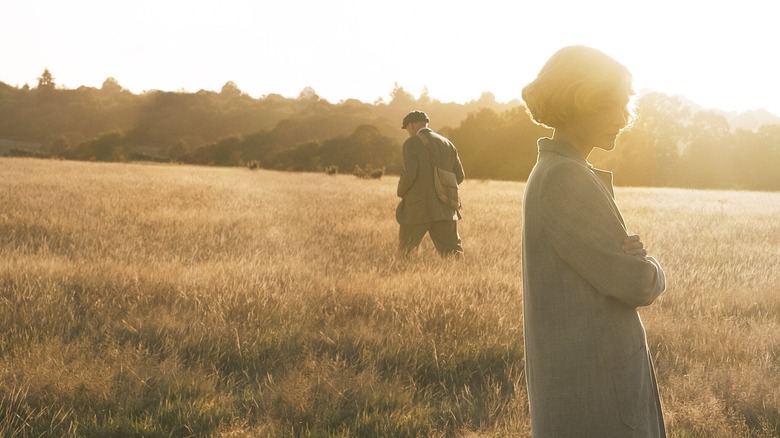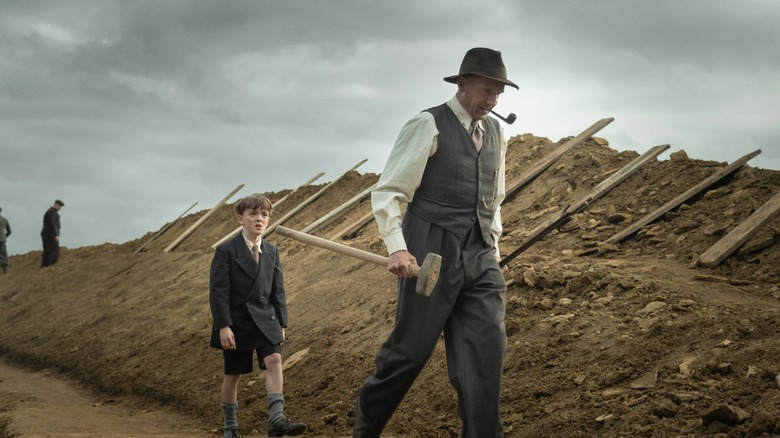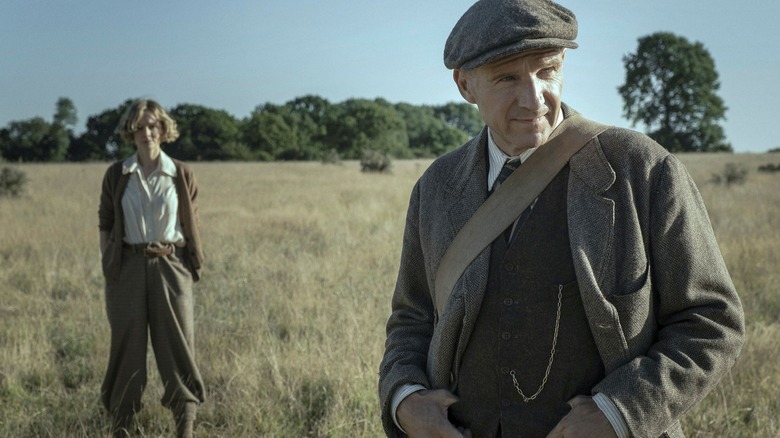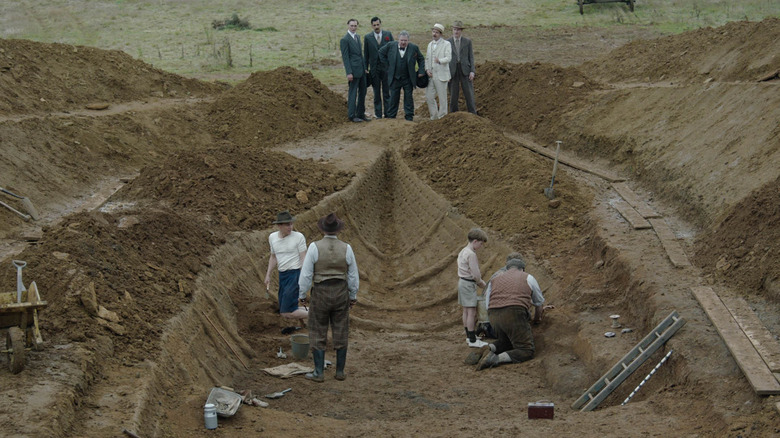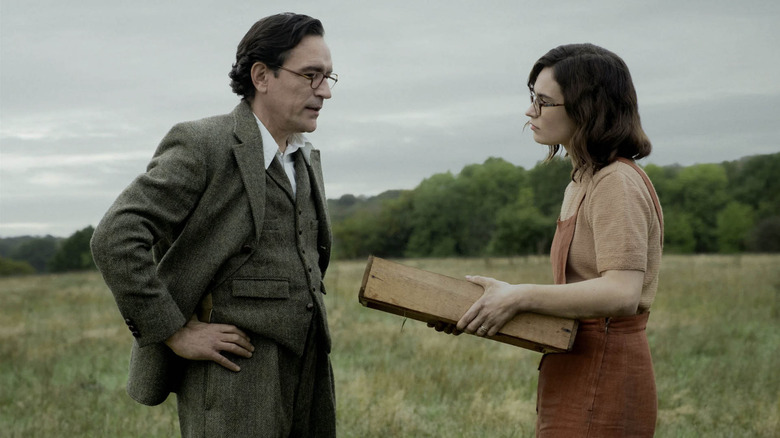The Interesting True Story Behind The Dig
What would you do if you found a hoard of gold in your garden? It's the stuff of childhood fantasy, and when I was little I would often dig up the flowerbeds searching for hidden treasure. It upset my dad, but could you really blame me? We lived only 10 miles from Sutton Hoo in Suffolk, UK, the site of the famous Anglo-Saxon ship burial and one of the most important archaeological finds ever made.
Nowadays, I live about 700 miles away, in the South Moravian heart of Europe. I don't get that homesick any more, but sometimes I miss the big open skies of my home county, with the ever-present cry of seagulls and the tang of salt in the air. There aren't a whole heap of films set in Suffolk (let's try to pretend "Yesterday" never existed), so naturally I was eager to see Netflix's "The Dig," which tells the tale of the wondrous Sutton Hoo discovery.
Starring Ralph Fiennes, Carey Mulligan and Lily James, "The Dig" was a modest hit for the streaming service early this year, earning favourable reviews and receiving nine BAFTA nominations. How does it compare to the true story that inspired it?
So What is The Dig All About?
Set in 1939, shortly before the outbreak of World War II, "The Dig" introduces us to Basil Brown (Fiennes), a local boy — in Suffolk dialect, every male aged 0-99 is "boy" — and amateur archaeologist who has worked on digs all his life. He is hired by Edith Pretty (Mulligan), an ailing widowed landowner, to excavate a series of mounds of her sprawling estate. Brown quickly deduces that they are part of sizable ancient burial site. He diligently gets to work.
With the onset of war, Brown's former employers at the Ipswich museum are eager to have him back working on the excavation of a Roman villa, but he only has eyes for his new potential discovery. When he unearths iron rivets, he suspects that he might have found a rare ship burial, indicating the last resting place of someone very important. The dig quickly gains national attention, attracting archaeologists from Cambridge who try to demote Brown, dismissing his expertise because he never finished school.
Luckily, Edith has Brown's back and she stands by him. Her faith is soon repaid when one of his team makes a remarkable discovery, and the true significance of the site becomes apparent...
What's the Big Deal About an Old Boat?
One of the strange things about "The Dig" is that, for a film about one of the greatest archaeological discoveries of all time, it gives little historical context and the treasure itself is limited to a brief cameo at the end. While Brown's methods weren't exactly Indiana Jones stuff, the discovery deserves more screen time than it gets here. Instead, Moira Buffini's screenplay is more interested in exploring the relationship between Brown and Pretty, and the other characters who gravitate to the site.
Perhaps conscious of the un-cinematic nature of the story — one critic described the experience of watching the film as like "sitting at a bus stop" — Buffini peppers the screenplay with moments of low-key drama. Brown gets buried in earth when his trench collapses, various experts try wrestling the find away from him, and so on.
It's a shame because the Sutton Hoo find was truly stunning, with huge historical significance. Here was a 27-meter-long ship serving as a tomb for someone of tremendous wealth and importance, dating back to 7th century Anglo-Saxon Britain. The stash of treasure contained within included items from places as far flung as Sri Lanka, and cast a fresh perspective on the time period. Prior to Sutton Hoo, historians believed that post-Roman Britain had descended into the Dark Ages.
The hoard now resides at the British Museum, where it dazzles visitors from all over the globe. As Sue Brunning, Curator of Early Medieval European Collections, puts it:
"The imagery of soaring timber halls, gleaming treasures, powerful kings and spectacular funerals in the Old English poem Beowulf could no longer be read as legends – they were a reality, at least for the privileged few in early Anglo-Saxon society."
How Historically Accurate is The Dig?
The story is fairly faithful to the real-life events of the Sutton Hoo dig, although, perhaps for brevity, it simplifies what an archaeologist actually does when they undertake an excavation. The Production Designer spent time at the British Museum with Brunning, poring over hundreds of sketches and photos to get the details just right. Similarly, Ralph Fiennes spent time with a Suffolk Dialect specialist to nail the county's distinctive twang, and to avoid the pitfall of sounding like a "West Country pirate." This training also involved sitting around in pubs listening to the locals speak. There are a few times when his usual RADA accent peeks through, but mostly he does a grand job.
The mutual antagonism between Brown and Cambridge archaeologist Charles Phillips (Ken Stott) was played up for dramatic effect, although Brown's diaries indicate they did have a "lively exchange of words" on one occasion. In reality, Phillips was quick to praise Brown on his work in his 1940 account of the dig. The screenplay overall is a little patronizing towards Brown, portraying him as a man with an almost mystical intuition of the landscape, although he was a well-respected excavator who had worked for the Ipswich museum for over 30 years.
Surely There Was No Controversy in The Dig?
You might think something as cosy and respectable-sounding as "The Dig" wouldn't have any controversy, right? That's where you would be wrong.
The film received accusations of ageism, as 35-year-old Carey Mulligan was cast in the role of a 56-year-old woman, leading people to question why someone of a more accurate age couldn't have played the part of Edith Pretty. Nicole Kidman, in her early 50s, was originally cast but pulled out. Mulligan gives a fine performance, but it's not like there are no other capable actors in that age range who couldn't have pulled it off — how about Cate Blanchett, Rachel Weisz, or even Gillian Anderson?
On the flip side, Ben Chaplin, then 51, was cast as archaeologist Stuart Piggott, a man in his late twenties. This creates a large age discrepancy between him and his on-screen wife, Peggy Piggott, played by the ever-youthful Lily James. The age difference was only a few years in real life.
There were also accusations of sexism for downplaying Peggy's importance to the dig. The film casts her as a bumbling novice hired only because her light weight wouldn't damage any delicate finds. This undersells the real-life Peggy, who was an experienced archaeologist who had overseen several excavations of her own.
Despite the mild controversy, "The Dig" is perfect autumn viewing, the cinematic equivalent of curling up on the sofa with a mug of cocoa. With its evocative sun-kissed photography, big open landscapes, and poignant sense of a world soon to be forever changed, it is no surprise that it found popularity during the height of the pandemic when so many folks were stuck at home. I suspect it will be cold-weather comfort viewing for many years to come.
